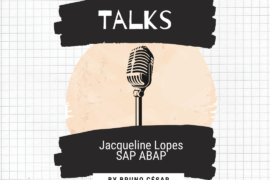In today’s post, I’ll tell you a little bit about my journey from the choice to the day of my APICS CLTD certification.
When I decided to get certified, I wished to find a post on the internet explaining the whole process, the biggest challenges, and the best study plan to get this valuable certification in the Supply Chain world.
But I could not find it.
What is APICs (Now ASCM)?
Association for Supply Chain Management is the leading transformation/innovation/leadership in Supply Chain.
It is a non-profit organization that has several deep training and certifications on the Supply Chain market in general.
In fact, this was one of the organizations that created the SCOR Model, which is used to standardize processes and KPIs within the Supply Chain world.
Among the main certifications offered by APICs/ASCM, we have:
- CSCP: Focused on the main concepts of the Supply Chain area.
- CLTD: Focused on the main concepts inside Logistics, Transportation, and Distribution.
- SCOR: Focused on the SCOR model.
- CPIM: Focused on planning and inventory management.
We can see that there are several options regarding topics within the Supply Chain world, and even though I studied only for CLTD, I imagine that the materials provided for all topics are as incredible as what I had the opportunity to study to prepare myself for the exam.
Why I chose CLTD Certification?
Before telling the reasons why I decided to choose the CLTD (Certification in Logistics, Transportation, and Distribution) certification, I will tell you a little about my professional background.
I have been working as an SAP consultant in Brazil for just over 10 years, having worked mainly within the MM module (Materials Management).
I love what I do, but I’ve always felt that my knowledge of Supply Chain processes was too “shallow” and to reach my mid-term professional goal (working as an SAP solutions architect in the Supply Chain area) I needed to pursue quality content from the best possible schools.
I made two decisions about this.
First, I started a great Supply Chain MBA program at Live University, which is totally focused on practical processes in the Supply Chain area. I started my MBA in September 2020 and I can say I’m loving the experience.
Second, after talking to a few people, I decided that I would certify for one of the APICS certifications.
I didn’t find much content on the Internet talking about certifications, so I decided to get in touch with several people who had been certified and ask how each one’s experience had been. This helped me a lot to decide.
My third step was to choose the certification itself. As I said before, there are several options and I thought for more than 1 month what would be the best certification for me.
In my case, I thought precisely about my medium-term professional plans, to choose a certification that covered all the topics at the business level that I intend to work within the SAP area.
My main interest is to act in the complete Supply Chain flow within SAP projects, that is, instead of acting only in MM (Materials Management) which mainly comprises the processes of purchasing, inventory, stock transfers, and invoice entry (which by itself, it’s already a huge world), my plan is to also work Warehouse Management (SAP-EWM module), Sales and Distribution (SAP-SD module) and in Transportation (SAP-TM module).
I know it’s an ambitious goal, but I believe it’s no use knowing the SAP modules very well and not knowing deeply the processes and concepts behind each one, and that’s why I chose the CLTD certification.
The APICs CLTD certification stands for “Certified in Logistics, Transportation, and Distribution”, meaning exactly the topics I was looking for.
I was very happy with my choice.
Starting the Process
There are a few ways to get certified by APICs.
The initial step is to decide if the professional will just purchase an exam voucher and study by itself, and try the certification exam, or the person can purchase the exam voucher and a learning system from APICs (that’s what I chose), or you can even take courses with instructors licensed by APICs itself to prepare and then take the certification exam.
I chose the option where I would have the right to take the certification exam, access the APICs online learning system and the printed material (Bundle).
I have absolutely no regrets about the option I have chosen.
You can see the options through the link below:
https://www.ascm.org/learning-development/certifications-credentials/cltd/
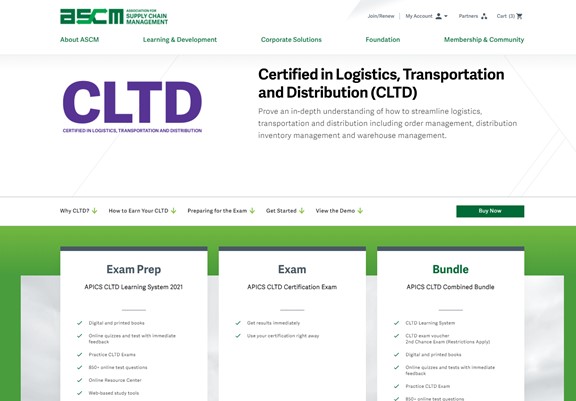
There is also the option to buy only the “Exam Prep” which is simply the study material without the voucher for the exam.
Compared to SAP certifications, the cost of APICs is a little something (I paid $1,383.08), but I guarantee everyone it’s totally worth it.
I bought the bundle on 01/20/2021:
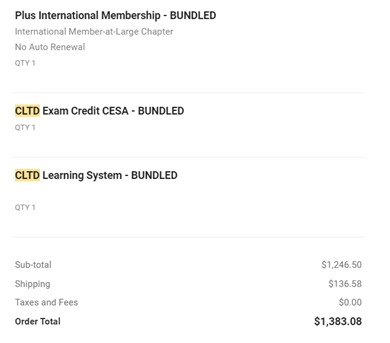
It is important to note that the price above also includes the shipping of printed material that was delivered directly to my home in Brazil.
A week later I received the two books for the CLTD:
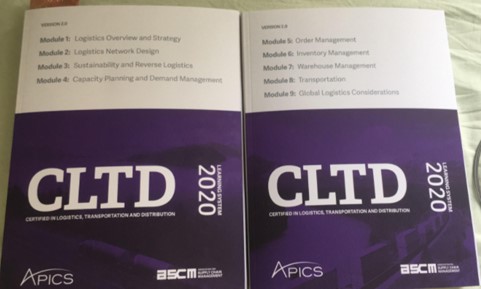
In addition, I immediately received access to the teaching platform:
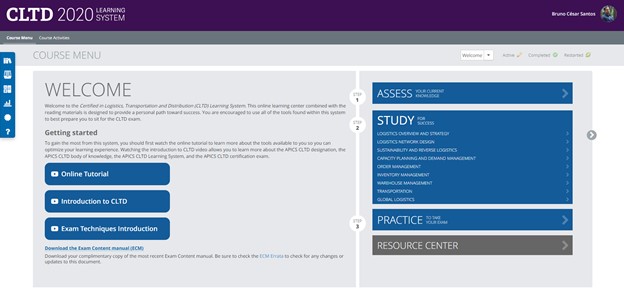
And so the journey began.
The Material
I confess that as I am not exactly a person from the Supply Chain area, the first reading of the material was not easy for me.
I didn’t know a lot of terms that were very specific to Supply Chain and that in my 10 years of SAP implementation projects I had never heard.
However, there my apprenticeship began.
The material for the CLTD is composed of 2 books where we have 9 chapters:
- Module 1: Logistics Overview and Strategy
- Module 2: Logistics Network Design
- Module 3: Sustaintability and Reverse Logistics
- Module 4: Capacity Planning and Demand Management
- Module 5: Order Management
- Module 6: Inventory Management
- Module 7: Warehouse Management
- Module 8: Transportation
- Module 9: Global Logistics Considerations
We have the option of reading in printed material (I prefer) or through the APICs online system.
On the platform itself, we have the option of putting together a study plan, which even starts with a placement test (I found it very interesting).
My first attempt was just terrible!
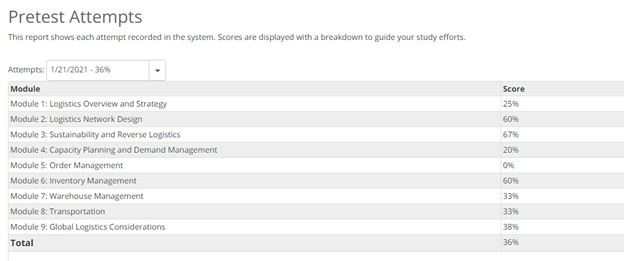
My overall score was only 36%.
Remembering that for the certification exam the candidate is required to achieve at least 300 points out of a total of 350 points. (about 85.7%).
In addition to the material I mentioned above, something I found extremely interesting was the “flashcards” that APICs make available so that candidates can practice the main concepts:


For each module, there is a list with flashcards, where you can print them (I did that) and on the front, you have the term and on the back the definition.
It may seem a little “silly” to use these cards, but I found it amazing that the first time I read them, I just didn’t know the definition of more than 10% of them (there are 70 in total), and the day before the exam I did (I didn’t memorize it, I really learned the concept from the material).
What I noticed during my journey is that the whole learning “experience” was thought out very carefully, because even at the beginning I had many fears if I would really learn, at the end of the journey I was very happy, because simply all the material was extremely useful to me.
In addition to all these features, the APICs online platform provides a simulated final exam (150 questions) and a quiz for each topic within each module.
My way of studying
You must be wondering how I did to study, how I organized myself, etc.
Even with the APICS Learning System’s suggestion, I wanted to do some tests and decided to follow a line of studies that worked for me when I got certified in some SAP exams.
My first step was to read all the material at once. Without writing a single word.
The result was a little scary. Because I noticed that I didn’t know anything about the subject (maybe 10%).
In fact, even though I was scared, I felt extremely challenged to do my best, as I already imagined how challenging this certification would be for me, as I am an SAP consultant.
Afterward, I decided that I would read the material once more, more calmly and for each topic within each module, I would write in a notebook what I learned.
Also, I read the flashcards for the module in question when I woke up, at lunch, and at night. (3 times a day).
My time for studying the material was always in the morning. It’s the time I have the best performance. After work hours, my brain is usually not as “tuned” as I am in the morning.
When I finished the module, I did all the quizzes for that module.
The result of each quiz was not very encouraging, but I knew that this was just the beginning.
I also decided to take a “practice exam” every Saturday, just to practice the exam.
There were 150 questions to be done in 3 hours. I used to take about 1:30 to finish it.
And so was my “second round” of reading.
At this point, I decided to ask some people through LinkedIn how much they had studied for the test, as I didn’t have any parameters for that.
APICs recommend a minimum 4 month preparation time for the exam, and I had decided that I wanted to take the exam in May 2021 (exactly 4 months), but I was beginning to feel that this would not be possible.
I talked to some people and they all told me that even though they were working in the Supply Chain area, the content and tests were really challenging and that I shouldn’t even try to take the test before reading the content at least 4 times and getting a score of at least 90% in the APICs online learning system simulations.
That’s exactly what I did.
I decided that I would read the entire material 2 more times and do simulations every day.
After reading the material 3 times, I created a table to map how I was doing (I’m a visual person):
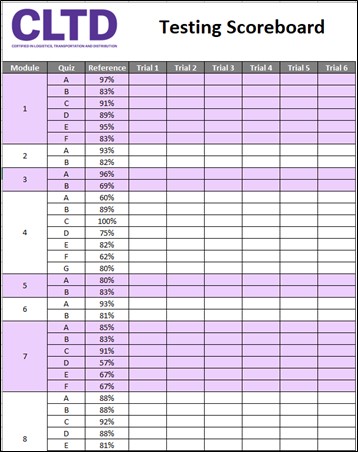
I printed this table and filled it out whenever I took a quiz on the learning system.
The information is always recorded on the website, but for me, this table helped a lot as I could easily see my progress.
The “Reference” column was simply my best score so far on that particular topic within the respective module.
And so it was.
I studied this way for about 3 hours a day on weekdays and studied for about 6 hours on Saturdays and Sundays.
The pace was pretty intense.
And like magic, in the second week of May 2021, I finished reading all the material for the fourth time.
My score on the practice test was around 98% and my score on all quizzes was above 90%.
It was exactly my goal.
I want to leave a piece of advice here.
Inside the APICS Learning System, there’s even a video saying exactly what I’m going to say: don’t memorize the content and the answers.
Because if you do this, I GUARANTEE you, you will learn absolutely nothing and you will not pass the certification exam, because in the certification exam there is not even simply 1 question equal to the simulated ones. The proof is based on concepts. 100% on concepts.
The Exam
After reaching the goals I had set myself (reading the material 4 times and scoring over 90% in all the simulations) I finally decided to schedule my certification exam.
On 05/17/2021 I scheduled the test for 05/20/2021 at 06:00 (Brazil time).
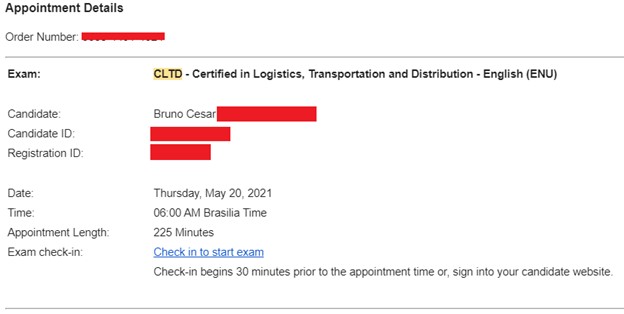
Why so early?
Because I’m a morning person and I always get up at 5:00. I have incredible energy at this time and I love the peace of the beginning of the day to study or exercise.
Scheduled the exam, I decided that I would just study a few concepts that were a little more difficult for me (especially about planning calculations) and set aside some flashcards to review.
I studied for 2 more days and decided not to study the night before the exam.
On 05/19/2021 I had a night off.
I went to bed early that day, but even though I didn’t consider myself an anxious person, I slept extremely poorly.
I woke up a little worried because I was tired, however, right after having a nice breakfast and going to the computer (I took the test online due to the quarantine) I was fully focused and ready for the exam.
I did the online check-in process and started the test exactly at 06:00. (Check-in process takes about 30 minutes).
When the first question appeared on the screen, I was really worried.
I had no idea the answer.
I decided not to despair and do my best.
The total test time was 225 minutes (3 hours and 45 minutes) and I was sure I wouldn’t have time issues.
I took the test very calmly, paying attention to every detail of each question, as the exam is very conceptual (in addition to several questions involving calculations) and I didn’t worry about the time.
When I was about 1 hour into the test, I was already at question number 60, which made me feel very calm.
I continued the test, calmly, without rushing, and when the clock said exactly 8:10, I got to the last question.
At the time of pressing the “finish” button, I didn’t know whether I was successful or not in the test.
Unlike the certification exams I had taken from SAP (3 exams), this time I really didn’t know if I had passed or not.
When I pressed the “finish” button, instead of the result, an APICs evaluation questionnaire appeared.
After answering the questions, it finally appeared:
“Congratulations Bruno. Pass. Score 311 out of 350”.
I couldn’t remember the last time I’d been so happy to pass an exam.
It really was an achievement.
24 hours after passing the test, I received my certification:
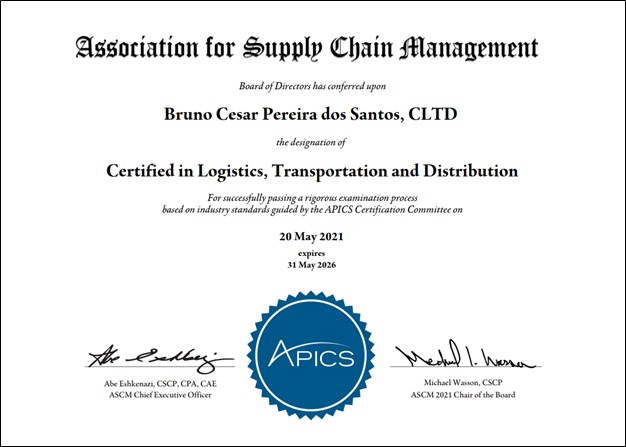
Conclusion
I hope this post (longer than I had planned) will help you understand my journey to achieve APICs CLTD certification.
My feeling is that it was really worth it. I learned a lot from books, simulations, quizzes, cards, etc.
The quality of the content positively surprised me and I am seriously considering studying for an upcoming APICs certification in 2022 (For 2021 I still want to take some SAP certification exams).
I want to take this opportunity to especially thank 3 people who helped me a lot with the various questions I had during this period:
- Jean-Yves (APICs CPIM): I had the pleasure of knowing through my blog www.sapsteps.com. Help directly from Paris.
- Marcela Fernandes (APICs CSCP): Who helped me with several questions through LinkedIn directly from Colombia.
- Lilia Kozlovska (APICs CSCP): Who has always helped me with many questions and has always responded promptly to all my inquiries directly from Switzerland.
Here I leave my thanks to you.
If you have any suggestions (including subjects you would like to read about), feel free to send an email to sapsteps@sapsteps.com.
A big hug,
Bruno César



